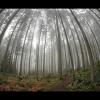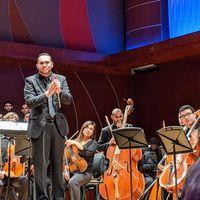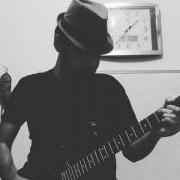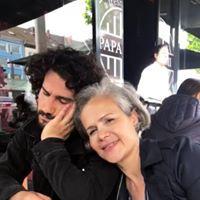Search the Community
Showing results for tags 'symphonic'.
-
Op.6 Symphonic Suite from Freyja - Vanadis
Vladisove posted a topic in Orchestral and Large Ensemble
Hey everyone! My name is Vlad, and in my free time, I dabble in composing what I like to call "pseudo-academic" music. I have absolutely no formal music education—just countless hours spent listening to classical works. I’d love to share my Symphonic Suite from Freyja - Vanadis, a piece heavily inspired by Sibelius and Wagner. -
Hey everyone! 🙂 This is my first post in the forum, so i greet you all. In this post, I present for review one of my last compositions, called "Into the mystical cave". It is small in duration and it has a soundtrack-like approach as it visualizes a trip through a mystical cave...I tried to put into the music the awe and wonder of exploring beautiful subterranean chambers. I use instruments from all families of the orchestra (and percussion). I would like your constructive opinions on the composition! Enjoy!
- 9 replies
-
- 2
-

-
- orchestral
- ost
-
(and 1 more)
Tagged with:
-
Good evening everyone! I'm ready to present a new piece I have been working on for the last couple of months or so: Adagio for Orchestra. It’s a relatively short piece, not as large in scope as some of my other works I have posted here. Admittedly I’ve had a little bit of writer’s block recently, so I toned things back quite a bit and instead focused on simple themes and experimenting with an expanded orchestra, including Euphonium and Saxophone with the usual instruments. I'm interested in any and all constructive feedback. I had a few goals in mind as I composed this, feel free to chime in on how well I accomplished them: Focus on simple, memorable themes. Experiment with orchestration, using auxiliary instruments to create some unique textures. Integrate Euphonium and Saxophone with the rest of the orchestra. Write something that would work as a middle movement of a larger work, such as a symphony. The piece is loosely structured in a binary form with repeat (ABAB). (0:00 - 1:09) – Introduction. Euphonium solo that is passed between and elaborated by other members of the winds, punctuated by sweeping string lines. Most of the thematic material from the piece is extracted from this opening solo. (1:09 – 2:41) – A Theme. A melancholy dirge carried by a bell-like ostinato played by harp, celesta, and piano, with rustling tremolo in the strings and an eerie chant in the winds. (2:41 – 5:00) – B Theme. A floating theme first presented by the oboe then embellished by the strings to the first big outburst of the piece. Material from the A Theme is elaborated here, then the strings carry the oboe theme to a new momentary high, before settling back into the recap. (5:00 – 7:11) – A Theme recap. The dirge returns, this time building to a euphoric climax, then drifting away into the upper register of the woodwinds and strings. (7:11 – 8:13) – B Theme recap. This time the clarinet sings the theme. I experimented with some polytonality/polymodality/whatever-you-want-to-call-it with the chords in the horns, trumpets, flutes, keyboards, and harp. I’m curious how well I pulled this off. (8:13 – 8:38) – Coda. Return of the Euphonium solo, this time drifting off into silence to end the piece. As usual, I have few specific questions I would like specific feedback on. Feel free to answer as many or as few as you wish: What effect does the music have on you? Does in conjure up an image? Or an emotional feeling? Does it tell you a story? This can be the piece as a whole, or a specific part or parts. What was your favorite part? What was your least favorite part? Do you have any comments or critiques on technique, e.g. harmony, melody writing, counterpoint, orchestration, voice-leading, etc.? How do you feel about the overall form? Is it effective? How well do you think the euphonium and saxophone are integrated with the rest of the orchestra? How do you feel about the harmony in the B theme recap (the nondiatonic chords against the melody in the clarinet)? Is it effective? Do you have any comments of the quality of the performance in the audio file? I really want this to be a decent representation of how the piece would sound if it were performed live, since it is unlikely it ever will be. Feel free to put your "conductor hat" on and critique the "orchestra". I have included a score and welcome any constructive feedback on its presentation. And if you're like me it's a lot more fun to follow along with the score. Are there any composers this reminds you of, that I might enjoy listening to? Sound libraries: Spitfire Symphonic Orchestra and Spitfire Percussion VSL – Eb clarinet, Bass clarinet (in the intro only), Alto sax, Bassoon (for the solo only), Bb Trumpet (for the solos only, and some reinforcement in louder sections), Euphonium, Piano Thanks for listening, I hope you enjoy! If you liked something I did and want me to explain how I did it, feel free to ask as well. -gmm
- 34 replies
-
- 11
-

-
- binary form
- saxophone
-
(and 4 more)
Tagged with:
-
Lieder - Katerina Stoykova-Klemer Librettist - Kawika Harper Some sounds generated by Garritan Mastered by, SageAudio
-
Good evening everyone, I am excited to present a new piece I have been working on: "Sinfonietta No. 2 for Large Orchestra". I have been working on this piece since last December (with a few interruptions due to the pandemic and life in general) and just added the finishing touches this last week. I chose what you might call an "extended" sonata form, with a longer introduction, exposition of two themes, development, recapitulation, and resolution/coda. I am interested in any and all constructive feedback. Since I just completed this piece, I'm very interested and open to ideas on how it could be improved. Like my last work, it is a little long clocking in around 20 minutes, so I broke it up into "chunks" if you want to listen a little bit at a time: (0:00 - 4:12) Introduction (0:00 - 1:33) A piercing opening that leads into a stormy "Infernal" theme (1:33 - 3:48) An ominous theme that leads into a passionate proclamation (3:48 - 4:12) - Brief return of the opening theme (4:12 - 5:48) Exposition of Theme A, a thundering overflow of aggression (5:48 - 6:32) Brief Transition from Theme A to Theme B (6:32 - 8:19) Exposition of Theme B, a wandering chromatic theme underscored by a heavy ostinato (8:19 - 14:03) Development, referencing and expanding the themes above, while deriving a few new ideas from the themes as well (14:03 - 15:35) - Recap of Theme A, transposed (15:35 - 16:00) - Brief Transition form Theme A to Theme B (16:00 - 17:45) - Recap of Theme B, transposed (17:45 - 20:18) - Resolution/Coda, a somewhat impatient, but ultimately triumphant finale As you listen, there are a few things I would like to hear your opinions on: What effect does the music have on you? Does in conjure up an image? Or an emotional feeling? Does it tell you a story? This can be the piece as a whole, or a specific part or parts. What was your favorite part? What was your least favorite part? Do you have any comments or critiques on technique, e.g. harmony, melody writing, counterpoint, orchestration, voice-leading, etc.? How do you feel about the overall form? Is it effective? Do any of the parts seem impractical to you? I tried to challenge myself with this piece and as a result I wonder if I pushed the expectations of some of the instruments too far. For example, I included "optional" Eb and D clarinet parts for some of the higher clarinet parts, but I'm not sure if it was necessary. I'm also not sure if some of the string technique in Theme A and the "Infernal" section is practical or not. Do any clarinet players or string players have any insight? Do you have any comments of the quality of the performance in the audio file? I really want this to be a decent representation of how the piece would sound if it were performed live, since it is unlikely it ever will be. For example "I would have liked xxx instrument to be louder/softer here" or "The xxx instrument technique sounds sloppy here and could use some cleaning up" or "The balance in the xxx section was all out of proportion" I have included a score and welcome any constructive feedback on its presentation. And if you're like me it's a lot more fun to follow along with the score. Do you think "Sinfonietta" is a appropriate designation, or would you call it something else? If you could name this piece, what would you name it? Thanks for listening and I hope you enjoy! As always, if you liked something I did and want me to explain how I did it I am happy to do so. Or if you just want to tell me it's awful that's fine too. gmm
- 31 replies
-
- 9
-

-
- orchestra
- large orchestra
-
(and 1 more)
Tagged with:
-
Hey Youngcomposers! Been a part of this community for years, and I'm so glad to see it's still growing! I wrote just a little adventure piece with some Celtic influences. I hope you enjoy it! I had a ton of fun writing it. Edit: I also threw this piece with some other ones on spotify. Feel free to take a listen! https://open.spotify.com/album/5I1tcYvpdeea9p3MQ5nrOQ?si=juYyyaajQVKWafkLuKM21Q
-
A local chamber orchestra was accepting scores from local composers, so I decided to write a piece vaguely related to some local folklore. It was fun! It's also in a loose sonata form. I don't usually bother writing in textbook forms like this, but my vague inspiration for the piece fit nicely into sonata form (the two themes relate to two different aspects of the lake--the mystery of the monster legend and the beauty of its surroundings). Following a prescribed form also allowed me to finish the piece quickly, and still allowed a good deal of creative freedom. Even though it's only for 14 instruments (1.1.1.1/1.1.1.0/1/harp/string quintet), I found I was able to get a lot more colour out of this group than out of a full wind ensemble in another recent piece... those strings are just so darn versatile. I'm generally happy with the orchestration in this one. But there are still some transitions near the end that bother me a little. Do they bother you? UPDATED Dec. 24 -- fixed some repetitive/boring sections and smoothed over a transition or two. Anyway, hope you enjoy it! https://issuu.com/nicholasryankelly/docs/watermarked_thelegendofokanaganlake
-
I notice I have a bad habit of disappearing from this site and reappearing randomly with new music but here we are now. The title is a work in progress still. But other than that, this came to be a thing when I looked outside one morning and saw it was snowing outside and the beginning of the piece stuck in my head and the rest is history.
-
New release by Sinfonia Varsovia. http://www.sinfoniavarsovia.org/en/-a-warsaw-polonaise-for-an-independent-poland-announcing-the-res.html
- 1 reply
-
- orchestral
- polonaise
-
(and 2 more)
Tagged with:
-
I like to introduce myself with poems. And a cape. But nobody can see my cape here so just forget I said anything. It is not malice, that the Gods should reward our prayers with mere images- for they must draw shadow hearts aloft, hearts that must die, hearts that stir in images only, hearts for which no vision at last fulfilled might prove inspiring, and want to glimmer only around the edges of things. It is not malice, that the gods please our hearts and not our souls, unless one speaks to the gods from their soul, and most souls do not pray, and hardly speak at all for the heart bears no malice. -- Pindar Pythian III. If one is to bear malice against the Gods and their cold silence toward our prayers, do so with the soul and bless them with the heart, and if that malice were to speak, one should reserve such speech for music I think. I was not sure where to place my post, however, considering I have a mix of general and more specific ideas as well as compositions themselves, I landed here. To be blunt, I'm an extreme isolate, having spent the last 14 years cloistered in my home, unrepentant of my dramatic reclusion, agoraphobia and likely even more extensive pathology while adopting an equally isolating mode of life as far as online interaction is concerned. In that time I have focused on composition a lot and arrived at around 50 or so volumes of compositions, each about 500 pages long, so already, it is a bit of a life's work. I've also arrived at a perhaps- odd personality, or a kind of intensification plainly evinced in my communication, one that naturally comes along with looking inward too incautiously-- one which I ask to be forgiven for in advance, for I now feel compelled to throw a few of these compositions out there as I study the matter and manner of publication, even though, again, I seem to have no sense or talent for social networking or anything of the sort. This appears to be the simplest way of going about it, making a post, that is. Of course I can answer questions about those elements of theory I either made use of or simply invented myself for their construction, and the scores are provided as well, as lengthy as some might be. I mixed the audio with headphones for all of these if that is relevant, I am still learning the audio engineering part which is necessary for me since most of the music I write is symphonic and can't be played by a single person, I must rely on layering audio tracks and on VSTS. To take elements from baroque, Romantic and modern advanced harmony- from modal theory to jazz, while exceeding the formal dimensions and limitations of all these genres and the respective horizons of meaning characterizing their eras in time and their possible relationship to the Divine, which I take music as representing more than any other art-form, I suppose is my guiding principle,- one very similar to Busoni's ideal of the Young Classicism, or junger Klassizität, which aimed at an interfusion of new harmonic and melodic content drawn from advances in modern theory with old, well evinced and dutifully refined forms drawn from the classical tradition. I wanted to include a few small pieces first, which reach about 12-15 minutes at their longest. The rubato capriccio is only four minutes in length, it uses a few elements from the old Spanish La Folia cadence, an erotic bit of delicious Italic decadence to balance my usual preoccupation with capturing the more transcendent feelings when it comes to music. https://audiomack.com/song/parodites/op-21-no-20 The score for this first one, compressed and printed on two staves: https://docdro.id/qz5hDud And expanded across four staves: https://www.docdroid.net/HE3BV4o/op-21-no-21-rev-12-pdf.pdf For the rest, I will provide compressed two-stave reductions since that is how I think musically and actually write: https://audiomack.com/song/parodites/op-33-no-3-cappricio-rubato Score: https://docdro.id/epBbNyQ * Capriccio https://audiomack.com/song/parodites/op-22-no-3-grande-fantaise-sur-thema-de-orpheus https://audiomack.com/song/parodites/op-22-no-6-ossia-and-cadenzas-for-grande-fantaise-sur-de-thema-de-orpheus Score: https://docdro.id/P2M3BbE https://audiomack.com/song/parodites/orpheus-20-mins I like this one but unfortunately the recording skips a little in the first few minutes and in a few other places, these are alternatives for the same, slightly different instrumentation, effects, setup, etc: Mov 1 and Omnibus: https://soundcloud.com/josephchambers/symphony-1-openingIncomplete Mov 2 and 3: https://audiomack.com/song/parodites/orpheusrecording-online-audio-converter-com ^ This one is the first movement from the first of my symphonic fantasies, which I titled Orpheus. Score: https://docdro.id/97EhwW3 https://audiomack.com/song/parodites/op-21-no-44-grande-fantaise-on-symphonic-fantasy-no-3 Score: https://docdro.id/x0CHB7f And then two finished larger-scale symphonic works, which are written in a musical form of my own design, the fantasy-symphony/symphonic-fantaisie, which I will make a few notes on at the bottom of this post: Piano Symphony-fantasia No. 2, Heroic Mov 1-4: https://soundcloud.com/josephchambers/heroicmov1-3 https://soundcloud.com/josephchambers/heroicmov4 Scherzo: https://audiomack.com/song/parodites/op-2-heroic-scherzo Score for the main four movements: https://docdro.id/1o24Lai And the score for its scherzo: https://docdro.id/4UL36L6 Phantasie-Symphony No. 4: https://audiomack.com/song/parodites/op6phansymph4 Score: https://docdro.id/ZowXETy I am formalizing a musical structure around my symphonic-fantasias. There are four 20 minute long movements making up each of them, and each of these four movements is subdivided into 3 movements of its own, or sections really, leaving out recapitulation within the subdivisions in order to establish a ternary formula. The first theme of each movement is a thematic transformation of the one before. So the first theme of the the second movement is a transformation of the theme that started the first. And then in the fourth and last movement, all of these first themes and secondary themes (each second theme is also a transformation of the second theme in the previous movement ) will be combined, arranged, and resolved to one finale. The formal plan is a combination of thematic transformation (Pioneered by Liszt) and recapitulation, ( a staple of the sonata-allegro formalism and the general theory of classical arrangement) the fourth movement serving as a massive recapitulation, as a movement that lends to recapitulation the same weight in the musical argument that the development section possessed formerly. The development section has always had a privileged weight in the literature, because it is process intensive and classical music is obsessed with process, ie. the process of composition and resolution, with introduction and recapitulation having secondary roles. The obsession with process began with the fugue, later evolving into the sonata-form. In the fugue it is most clearly seen: a melody, weak in itself, (in terms of expressive power) is polyphonically textured: the melody in terms of its introductory role in the three divisions of intro, development, and recap, only serves as a basic germ to be explored by the process of composition itself, an exploratory gesture pointing toward the greater analogical mimesis of the longing of longing itself, the longing for longing itself, Augustine's amor amoris or of the "lover in love with love", the deep excess "which survives in the heart of the saints like the worm in fruit", "the god-struck discontent of which man is truly a son", which draws his face to the stars out of longing, though he only gazes upon the stars because he does not know what to long for-- 1 the melancolia permeating all great works in the search for mankind's relationship to the divine, a golden symbol whose exploration these given works above all represent to us. There is in fact greatness to be found in this attitude toward art. However, in Romantic music, we find melodies with incredible expressive power, a power granted by the further development of chromatic coloration and the incorporation of the full harmonic series and those intervals not made truly available to the artistic imagination in Bach's time when the fugue was in vogue. The further development of harmony led to this unavoidable musical problem: if melody is granted this incredible expressive power, how is a melody to serve the purposes of theme, that is, how is a melody to be incorporated into a larger musical text: the purpose of that musical text, of any musical text, whether its architecture is found in the sonata, fugue, etc. is simply to make the melodies complete by developing and finding their place in a greater whole- if they are already complete in themselves, where do we go with them? These Romantic melodies cannot be developed by fugal writing, they cannot be further incorporated in this way into a larger musical argument. Even the sonata form was eventually abandoned, with Liszt advancing the idea of thematic transformation in his Symphonic poems, though it had precedent in Schuber's Wanderer Fantasy, and in Beethoven's unusually lengthy manner of composition. My new symphonic-fantasia is an attempt to develop a structure that allows such melodies to be developed in the context of a larger musical process once again, while lending equal gravity to recapitulation so as not to get fully absorbed into the development sections, like especially happens in Beethoven's development for the Eroica. I might bring further light to the function of the symphonic phantasy with this excerpt of Drabkin's, on the subject of Beethoven's Mass. " It is generally agreed that the music of Beethoven's maturity is among the most highly organized in the repertory of the 18th and 19th centuries, and that the analysis of any work- choral or instrumental- should take into account not only the structure of the individual movements but also the connections between them. Music theory, however, is conventionally concerned with dynamic processes- chord progressions, melodic motion, musical form as movement between regions of instability and stability- and is ill equipped as a theory to determine the conditions under which one can sensibly draw connections between distant points, for example on the basis of thematically similar material. " It is this later matter I am concerned with, that is, creating thematic linkages between the most distant objects in the given musical structure. I suppose that fact, combined with my free interfusion of traditions as varied as Romanticism to jazz, would imply simply: I am searching for a new music, a new harmonic and melodic landscape. 1. Irreverent of my intellectual vanity, I was referencing a few of my own works of philosophy and prose here: To love is to grieve over the loss of something that was never ours. It is a feeling of separation and self-estrangement from something nonetheless unknown and that was never part of us, a feeling of somehow having finally been made whole by being broken apart. It represents that state of inspired displicency so characteristic of man, which leaves him forever the unsatisfied and bereft wanderer of the earth; that state in which the material basis of our desires refutes itself by means of the very abundance of its fulfillment, and in which man grows quite sickened by exhausting his pleasures of their last, sweetened drop. The true scope of that unconscious basis from which we are so estranged, the yearning for which all of life is absorbed as by a dim hypnogeny, could not possibly be circumscribed by any object of our hopes and faith, and no matter how well developed merely human felicity might become, there is consequently a sigh of melancholy which must always enliven and animate it, which must pass over and carry it, like the bird's feather tangled in the angel's mane. It is only because he does not know what to yearn for, that man raises his gaze to meet the heavens and yearns for the stars. What is called reason is not the part of human nature that stands opposed to the animality of man, it is not properly what makes man something more than a beast. The animals possess reason as well, they simply reason somewhat poorly. That alone possessed by man is this slight remanence of disassociated longing which survives his extinguished pleasures here on earth, which raises his head toward the stars; what is called fantasy, or madness, the god-struck discontent of which he is truly the son. Experience, when it is not paired with this imaginative capacity, is but memory; and memory, divorced from the same capacity, is but regret. This "love for the unknown beloved" has compelled each philosopher, in his own way, to contribute his own symbol to the generalized mythos of the depth of the soul, the soul's unconscious intimation of the distant unknown for which it consciously strives. One may call to mind the incurvatus in se, the turning inward of the Christian soul, the katabasis of the Greek myths, or the Platonic vision of Eros. One may call to mind the eternal recurrence of Nietzsche, in which the soul's untold depth is emptied into an unbounded future that has itself been submerged in the past; one may call to mind Kierkegaard's leap of faith, by which the irresolvable tension of the self's underlying agonism and depth transcends the limitations of synthetic logic by way of heavenly grace; the divine excess of Schelling's freedom, or the Dasein of Heidegger, which reveals the soul's depth by means of a timeless confrontation with the external universe. In each such symbol the soul braves the unknown abyss of itself, choosing to divorce itself from a world in which it has not been able to empty that depth of its hidden contents and in which it has found no satisfaction of its displaced yearning. Every philosophy amounts to an enlivening of this one basic dream, a kind of reinvention of this fundamental symbol. Yet, in each new symbol there is brought forth a moment in which the self's orientation with the depth and the unknown beloved can be altered, a moment in which the production of a new subjectivity can be attained.
- 1 reply
-
- multigenre
- duet
-
(and 2 more)
Tagged with:
-
I would love some feedback on the composition in general and the orchestration. The score is in concert pitch thus it´s easier to read. The score and engraving is not yet perfect, I am aware! Thanks! https://www.youtube.com/watch?v=mKkrsACLiCI
-
-
A small concerto (concertino) in a movement. It has a classical style mixed with a "romantic orchestration" It was composed back in 2015 for a 2016 premiere with the High school Concert Band from Escuela Libre de Musica The composition has some novice errors hehe, also I'm conducing, so I apologize for the dancing. I included the audio .midi and the premiere back in 2016 with the Escuela Libre de Musica Concert Band and Angel Cuyar as soloist. As always, feedback is welcomed!
- 3 replies
-
- symphonic
- concert band
-
(and 4 more)
Tagged with:
-
First post here, this is an orchestra work I did a while back as an ode to Virginia (My home state) it takes you through various regions of the state such as the Tidewater, the Appalachians, the Blue Ridge, and the Shenandoah valley. I was inspired to write this when hearing the intro for Appalachian Spring by Copland. I remember our teacher saying it was meant to capture a morning in the Appalachian Mountains (where my family is from), and thinking to myself that Copland nailed it, but I wanted a piece that would do the same for the whole of Virignia (Or at least parts of it). I sought to emulate this in the beginning of the piece. The piece concludes with my take on Oh, Shenandoah. A river that rolls through Virginia which I spent many summers on. Let me know what you think, and yes I know the score is horribly engraved.
-
Just another preview I made for the video game we are working on ... I was asked to describe a Jinn (some kind of demon in Middle eastern culture, referenced in Qur'an, and also Iranian and Arabian legends and mythologies) with music. But, this Jinn is not a typical Jinn (to help you imagine Jinn, you can consider "baphomet" without wings). This Jinn shows himself as a human with a mask to people, and he doesn't annoy or injure them until they make him angry. Also, I was asked to include Iranian folk instruments in my music. And, I made this :
-
Sinfonia I.mid
-
Thanks to all enjoyed my previous topic whereas I posted several pieces I've written which you can find at this link: Batch Pt. 1 & 2 In this topic I would love to share a political video I've written, accompanied by a piece I worked really hard on. It describes the nature of what we became as a species and painful truths: Below is a piece I've written to describe what it would feel like to travel through the devil's gate for the first time starting from the beginning. When it begins to pick up in tempo toward the middle, I wanted to give a sense of Heaven vs. Hell. When the female voice come in at the end, it is my depiction of Eve feeling much guilt and shame for cursing women due to temptation and is singing from Hell for God's forgiveness. Finally, in the music player below are several pieces that were left unfinished, either due to my: laziness, exhaustion, or I was unmotivated. (Note: The piece entitled "track 4" was an unfinished collaboration with a member who lost her user name? She hasn't logged in for a while now.) Hope you guys love the music and please be sure to post your critiques!
-
Hi, I would like to share some of my previous works to newer members and anyone who would love to listen to them. And guys if you have enjoyed listening to these, please visit an earlier post where I also uploaded my most popular viewed pieces here at this link: Batch of Pieces Pt. 2 I would love to hear your feedback and allow me the chance to follow your music and also enjoy what you guys have posted. Thanks a lot everyone!
-
symphonic small symphonic miniature in b-moll
Dinosaur posted a topic in Orchestral and Large Ensemble
My first experiment to express a few of my musical ideas. This composition is in need for some opinion. -
Hey young composers, I have composed a short Adagio for Orchestra! Feel free to review it! http://soundclick.com/share.cfm?id=13606288 kind regards K. D.
-
this is the piece I newly composed, hope everyone like it.
-
Hello, this is my new song about Spring. I'm sorry if I'm late. :D I didn't have much time to write music these days. I hope, you'll like my new work, please write your opinion in comment! https://soundcloud.com/mardumusix/oliver-kovacs-spring-is-coming
-
Live Orchestra Recordings (Budapest)
FredericBernard posted a topic in Orchestral and Large Ensemble
Hey guys, I did some live recordings with the budapest scoring orchestra in 2015, here's my favorite one, "Spaghetti Con Brio", enjoy! : (mix by Greg Townley) They had just around 25 minutes to record that piece but pretty much nailed it (the runs in the middle part are ridiciously hard). Here's another one, I especially enjoyed the strong brass playing: (mix by Greg again, his work was amazing on this one) And then I did another shorter one, but in a moore cartoon style direction: (mixed by John Rodd) This one is the last work I did (new to come!) and is again kinda Disney, but a bit more heroic. Actually especially the first part is inspired quite a lot from John Ottman's Astroboy (fantastic score btw, check it out if you didn't yet). If you'd like to hear more, check out my other works. http://fredericbernardmusic.com/listen/ As I was asked by a lot of people; you can download pdf scores for all compositions here: http://fredericbernardmusic.com/pdf-scorestutorials/ As an introductory offer you can download the Mr. Alice and Spaghetti Con Brio full conductor scores for free (by just clicking on the download button) you name the price for the other two scores, starting at just 1 $. Feedback would be highly appreciated! :) -
Hey Guys, This is my new creations. I really interested in your opinion, please write in comment! Thanks!
- 2 replies
-
- sci-fi
- dramatic music
-
(and 6 more)
Tagged with:










